VOLKSWAGEN TRANSPORTER 1990 T4 / 4.G Owners Manual
Manufacturer: VOLKSWAGEN, Model Year: 1990, Model line: TRANSPORTER, Model: VOLKSWAGEN TRANSPORTER 1990 T4 / 4.GPages: 165, PDF Size: 24.87 MB
Page 111 of 165
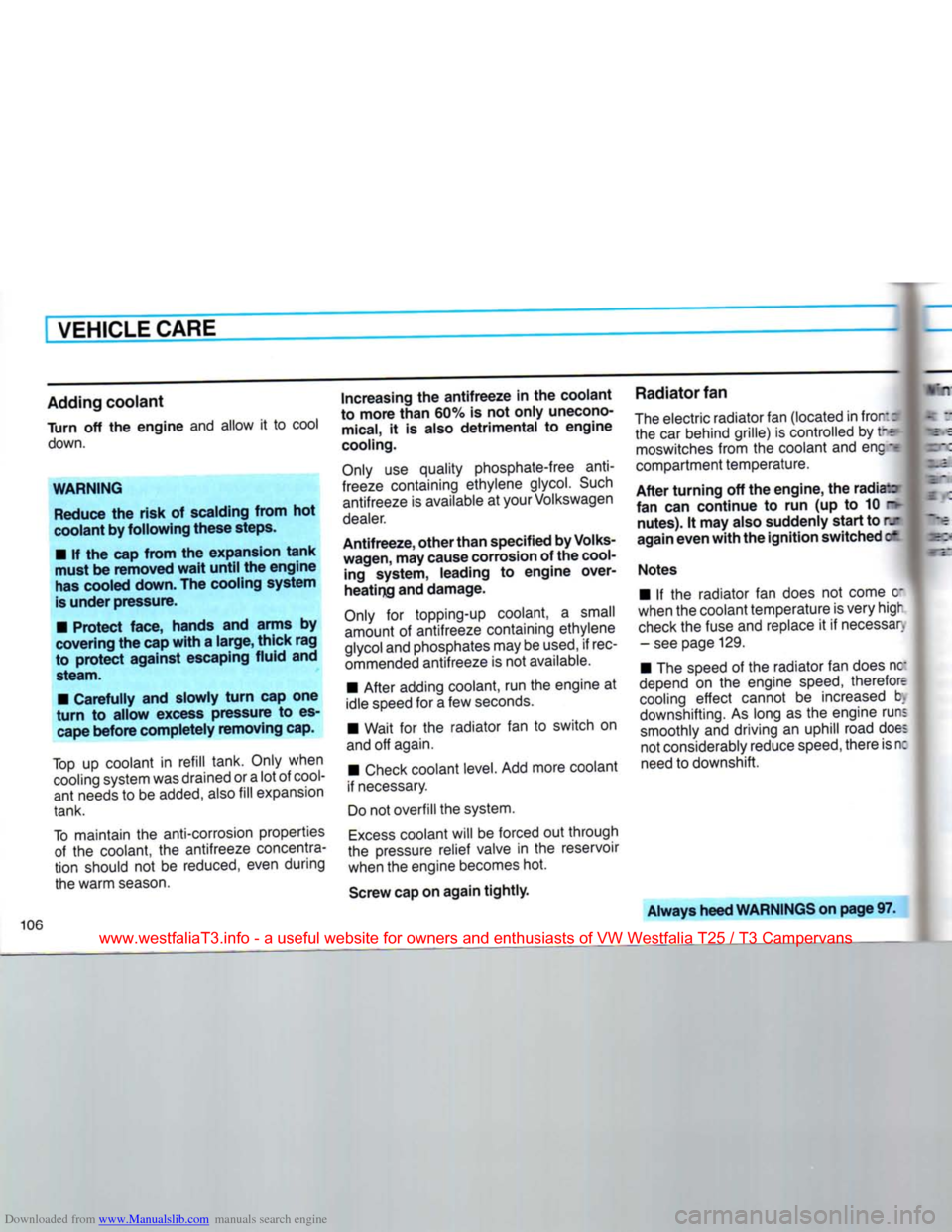
Downloaded from www.Manualslib.com manuals search engine
VEHICLE CARE
Adding
coolant
Turn
off the
engine
and allow it to cool
down.
WARNING
Reduce the
risk
of scalding
from
hot
coolant
by
following
these
steps.
• If the cap
from
the expansion
tank
must
be
removed
wait
until
the
engine
has cooled down. The cooling system
is
under
pressure.
•
Protect
face, hands and
arms
by
covering the cap
with
a
large,
thick
rag
to
protect
against
escaping
fluid
and steam.
•
Carefully
and
slowly
turn
cap one
turn
to
allow
excess pressure to es cape
before
completely
removing
cap.
Top
up coolant in refill tank. Only when
cooling
system was drained or a lot of
cool
ant needs to be added, also
fill
expansion
tank.
To
maintain the anti-corrosion properties of the coolant, the antifreeze concentra
tion should not be reduced, even during
the warm
season.
Increasing
the
antifreeze
in the
coolant
to
more
than
60% is not
only
unecono mical, it is also
detrimental
to
engine
cooling.
Only
use quality phosphate-free anti
freeze
containing ethylene glycol. Such antifreeze is available at your Volkswagen
dealer.
Antifreeze,
other
than
specified by Volks
wagen,
may cause corrosion of the cool ing system,
leading
to
engine
over
heating
and
damage.
Only
for topping-up coolant, a small amount of antifreeze containing ethylene
glycol
and phosphates may be
used,
if rec
ommended antifreeze is not available.
• After adding coolant, run the engine at
idle speed for a few seconds.
• Wait for the radiator fan to switch on
and
off again.
• Check coolant level. Add more coolant
if necessary.
Do
not overfill the system.
Excess
coolant will be forced out through
the pressure relief valve in the reservoir
when the engine becomes hot.
Screw cap on
again
tightly.
Radiator
fan
The
electric radiator fan (located in
fror:
r the car behind grille) is controlled by !':
moswitches
from the coolant and enc
TE
compartment temperature.
After
turning
off the
engine,
the
radiate
fan can
continue
to run (up to 10 r>
nutes).
It may also suddenly
start
to rx
again
even
with
the
ignition
switched
c*
Notes
• If the radiator fan does not come c
when the coolant temperature is very high
check
the fuse and replace it if necessar, - see page 129.
• The speed of the radiator fan does nc
depend
on the engine
speed,
therefore
cooling
effect cannot be increased b.
downshifting. As long as the engine runs smoothly and driving an uphill road does
not considerably reduce
speed,
there is n:
need
to downshift.
Always
heed
WARNINGS
on
page
97.
www.westfaliaT3.info - a useful website for owners and enthusiasts of VW Westfalia T25 / T3 Campervans
Page 112 of 165

Downloaded from www.Manualslib.com manuals search engine
V-BELT
winter operation
I the beginning of the winter season, have the coolant checked for anti-freeze
ecncentration. If you have to add, only use
Hality
phosphate-free anti-freeze con-
ra. ning ethylene glycol which is available
5".
your Volkswagen dealer.
Tie ratio between water and anti-freeze
r-pends
on the anticipated outside temp-
r'atures. Tension checking
Correct V-belt tension is important for over
all vehicle performance.
Tensioning and replacing of vehicle V- belts should be performed by your
Volkswagen dealer or a qualified work shop.
See page 147 for V-belt designation.
WARNING
To prevent personal injury stay well clear of the V-belt when the engine is
running.
Before checking V-belt
ten
sion turn the engine off and let it cool
down.
Hot components can burn skin
on contact.
Always heed WARNINGS on page 97. 107
www.westfaliaT3.info - a useful website for owners and enthusiasts of VW Westfalia T25 / T3 Campervans
Page 113 of 165
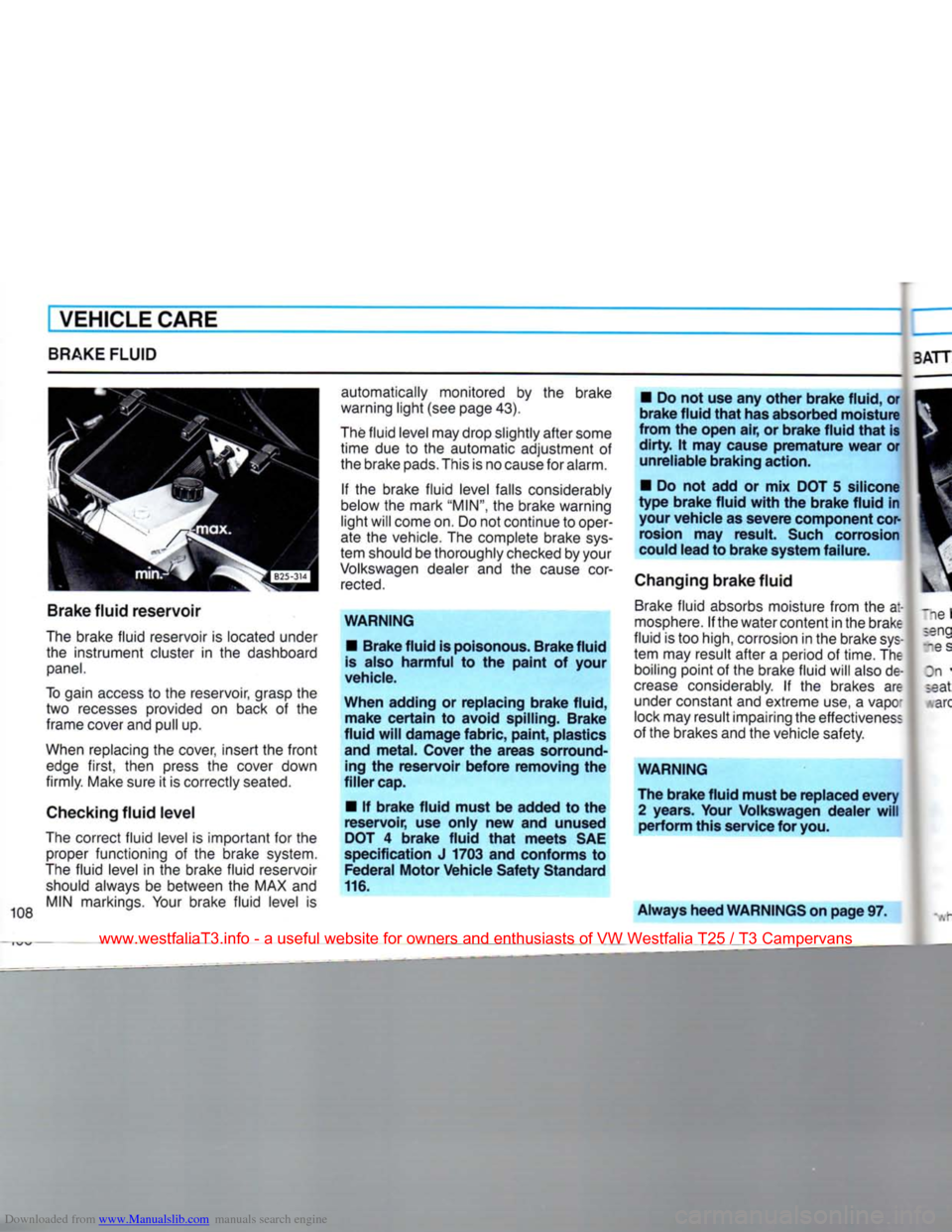
Downloaded from www.Manualslib.com manuals search engine
VEHICLE CARE
BRAKE FLUID 3 ATT
108 Brake fluid reservoir
The brake fluid reservoir is located under the instrument cluster in the dashboard
panel.
To gain access to the reservoir, grasp the two recesses provided on back of the frame cover and pull up.
When replacing the cover, insert the front edge first, then press the cover down
firmly. Make sure it is correctly seated.
Checking fluid level
The correct fluid level is important for the proper functioning of the brake system.
The fluid level in the brake fluid reservoir should always be between the MAX and MIN markings. Your brake fluid level is automatically monitored by the brake
warning light (see page 43).
The fluid level may drop slightly after some time due to the automatic adjustment of
the brake pads. This is no cause for alarm.
If the brake fluid level falls considerably
below the mark
"MIN",
the brake warning
light will come on. Do not continue to oper
ate the vehicle. The complete brake sys
tem should be thoroughly checked by your
Volkswagen dealer and the cause cor
rected.
WARNING • Brake fluid is poisonous. Brake fluid
is also harmful to the paint of your
vehicle.
When adding or replacing brake fluid, make certain to avoid spilling. Brake
fluid will damage fabric, paint, plastics and metal. Cover the areas sorround-ing the reservoir before removing the
filler cap.
• If brake fluid must be added to the
reservoir, use only new and unused
DOT 4 brake fluid that meets SAE
specification J 1703 and conforms to Federal Motor Vehicle Safety Standard
116.
• Do not use any other brake fluid, or
brake fluid that has absorbed moisture
from the open air, or brake fluid that is
dirty. It may cause premature wear or unreliable braking action.
• Do not add or mix DOT 5 silicone
type brake fluid with the brake fluid in your vehicle as severe component corrosion may result. Such corrosion
could lead to brake system failure.
Changing brake fluid Brake fluid absorbs moisture from the at
mosphere. If the watercontent in the brake
fluid is too high, corrosion in the brake sys
tem may result after a period of time. The boiling point of the brake fluid will also de
crease considerably. If the brakes are under constant and extreme use, a vapc
lock may result impairing the effectiveness
of the brakes and the vehicle safety. -e s
Dn seat arc
WARNING
The brake fluid must be replaced every 2 years. Your Volkswagen dealer will perform this service for you.
Always heed WARNINGS on page 97.
www.westfaliaT3.info - a useful website for owners and enthusiasts of VW Westfalia T25 / T3 Campervans
Page 114 of 165
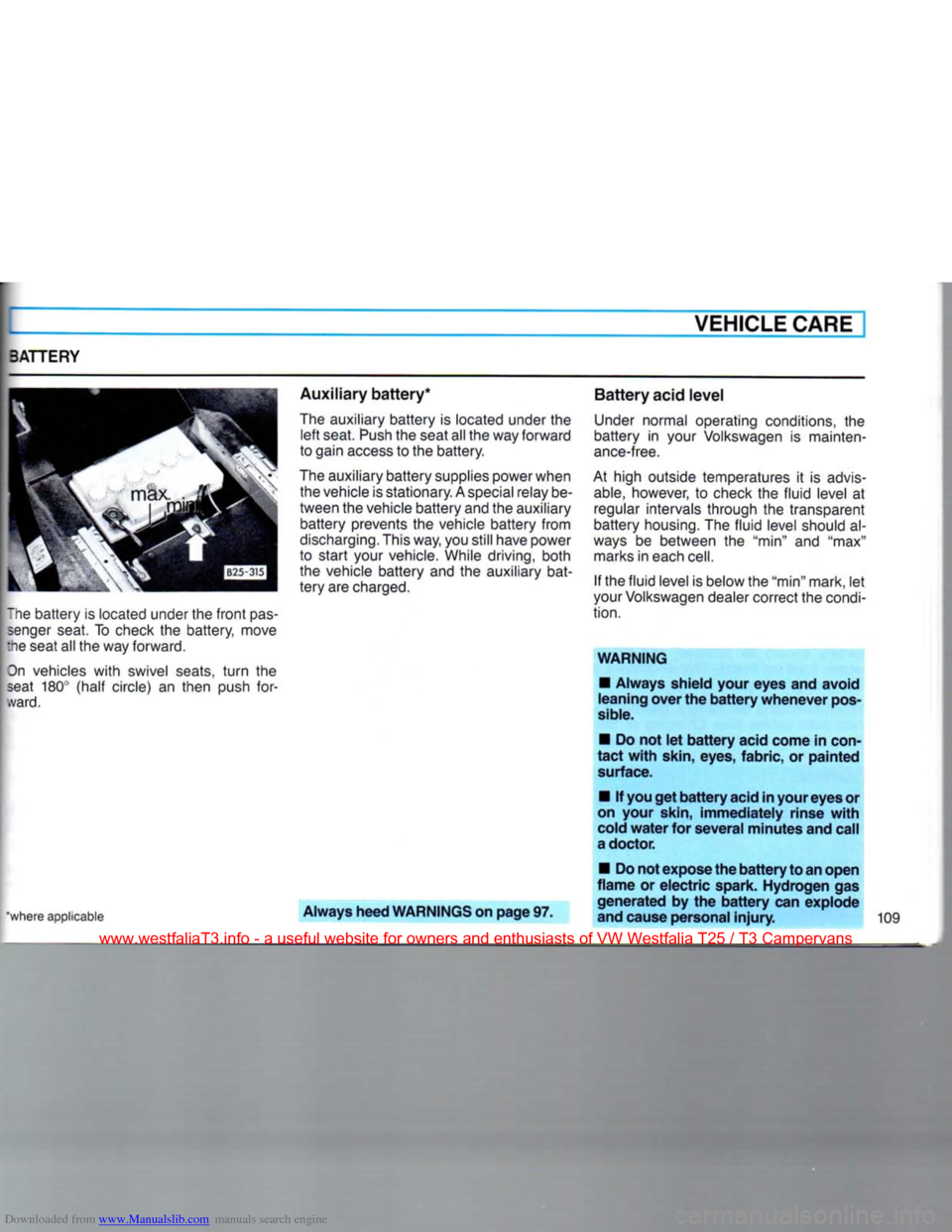
Downloaded from www.Manualslib.com manuals search engine
VEHICLE CARE
3ATTERY
~he battery
is
located under the
front
pas
senger
seat.
To
check
the
battery, move
lie
seat all the way forward.
On
vehicles
with
swivel seats,
turn
the
seat
180°
(half circle)
an
then push
for
ward.
Auxiliary
battery*
The
auxiliary battery
is
located under
the
left
seat.
Push
the
seat all the way forward
to gain
access
to
the battery.
The
auxiliary battery supplies power when the vehicle is stationary.
A
special relay be
tween the vehicle battery and
the
auxiliary battery prevents
the
vehicle battery from
discharging.
This way, you still have power
to start your vehicle. While driving, both
the vehicle battery
and the
auxiliary bat
tery are charged.
'where applicable
Always heed WARNINGS on page 97. Battery acid level
Under
normal operating conditions,
the
battery
in
your Volkswagen
is
mainten
ance-free.
At high outside temperatures
it is
advis
able,
however,
to
check
the
fluid level
at
regular intervals through
the
transparent
battery housing. The fluid level should
al
ways
be
between
the "min" and "max"
marks
in
each
cell.
If
the fluid level
is
below the "min" mark,
let
your Volkswagen dealer correct
the
condi
tion.
WARNING
•
Always shield your eyes and avoid
leaning over the
battery
whenever
pos
sible.
•
Do not let
battery
acid come in
con
tact
with
skin,
eyes, fabric, or painted
surface.
•
If
you
get
battery
acid
in
your eyes or
on
your
skin,
immediately rinse
with
cold
water
for several minutes and call a doctor.
•
Do not expose the
battery
to an open
flame
or electric spark. Hydrogen gas generated by the
battery
can explode
and cause personal injury.
109
www.westfaliaT3.info - a useful website for owners and enthusiasts of VW Westfalia T25 / T3 Campervans
Page 115 of 165
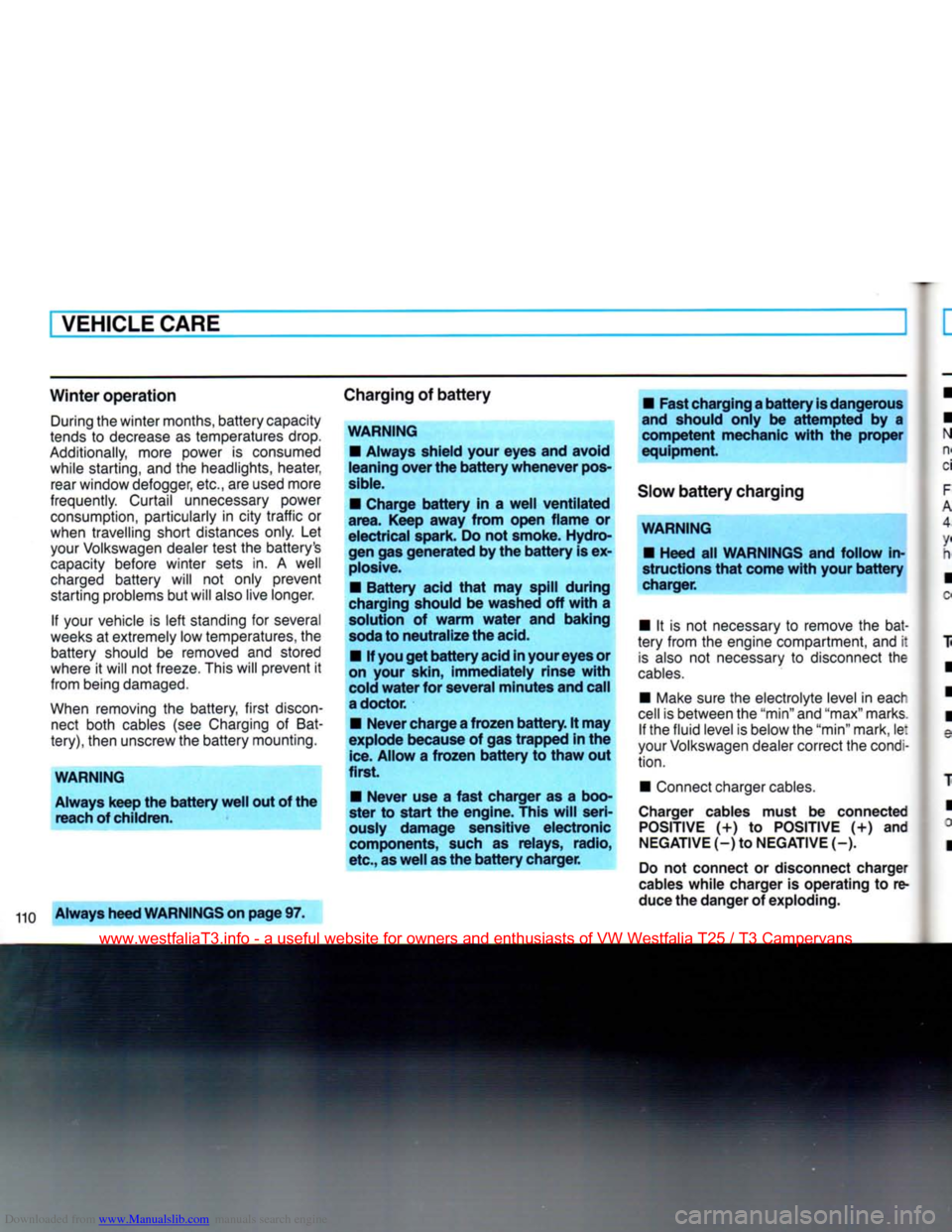
Downloaded from www.Manualslib.com manuals search engine
VEHICLE
CARE
Winter operation During the winter months, battery capacity
tends to decrease as temperatures drop.
Additionally, more power is consumed while starting, and the headlights, heater, rear window defogger, etc., are used more
frequently. Curtail unnecessary power
consumption,
particularly in city traffic or
when travelling short distances only. Let
your
Volkswagen dealer test the battery's
capacity before winter sets in. A well
charged battery will not only prevent
starting
problems but will also live longer.
If
your
vehicle is left standing for several
weeks
at extremely low temperatures, the battery should be removed and stored
where it will not freeze.
This
will prevent it
from being damaged.
When removing the battery, first discon nect both cables (see Charging of Bat
tery),
then unscrew the battery mounting.
WARNING
Always keep the battery well out of the reach of children.
Always heed WARNINGS on page
97.
Charging of battery
WARNING
•
Always shield
your
eyes and avoid
leaning
over
the battery whenever pos
sible.
•
Charge battery in a well ventilated
area.
Keep away from open flame or
electrical
spark. Do not
smoke.
Hydro gen gas generated by the battery is explosive.
•
Battery acid that may spill during
charging should be washed off with a solution of warm water and baking
soda
to neutralize the
acid.
•
If you get battery
acid
in
your
eyes or
on
your
skin,
immediately rinse with
cold
water for several minutes and
call
a
doctor.
•
Never charge
a
frozen battery. It may
explode because of gas trapped in the
ice.
Allow a frozen battery to thaw out
first.
•
Never use a fast charger as a boo
ster to start the engine.
This
will
seri
ously damage sensitive electronic
components,
such as relays, radio,
etc.,
as well as the battery charger.
•
Fast charging
a
battery
is
dangerous
and should only be attempted by a
competent mechanic with the proper
equipment.
Slow battery charging WARNING
•
Heed all WARNINGS and follow in
structions that come with
your
battery
•
It is not necessary to remove the bat
tery
from the engine compartment, and it
is
also not necessary to disconnect the
cables.
•
Make sure the electrolyte level in each
cell
is between the "min" and "max" marks. If the fluid level is below the "min" mark, le:
your
Volkswagen dealer correct the condi
tion.
•
Connect charger cables.
Charger cables must be connected
POSITIVE
(+) to
POSITIVE
(+) and
NEGATIVE
(-) to
NEGATIVE
(-).
Do not connect or disconnect charger
cables
while charger is operating to re
duce the danger of exploding.
www.westfaliaT3.info - a useful website for owners and enthusiasts of VW Westfalia T25 / T3 Campervans
Page 116 of 165
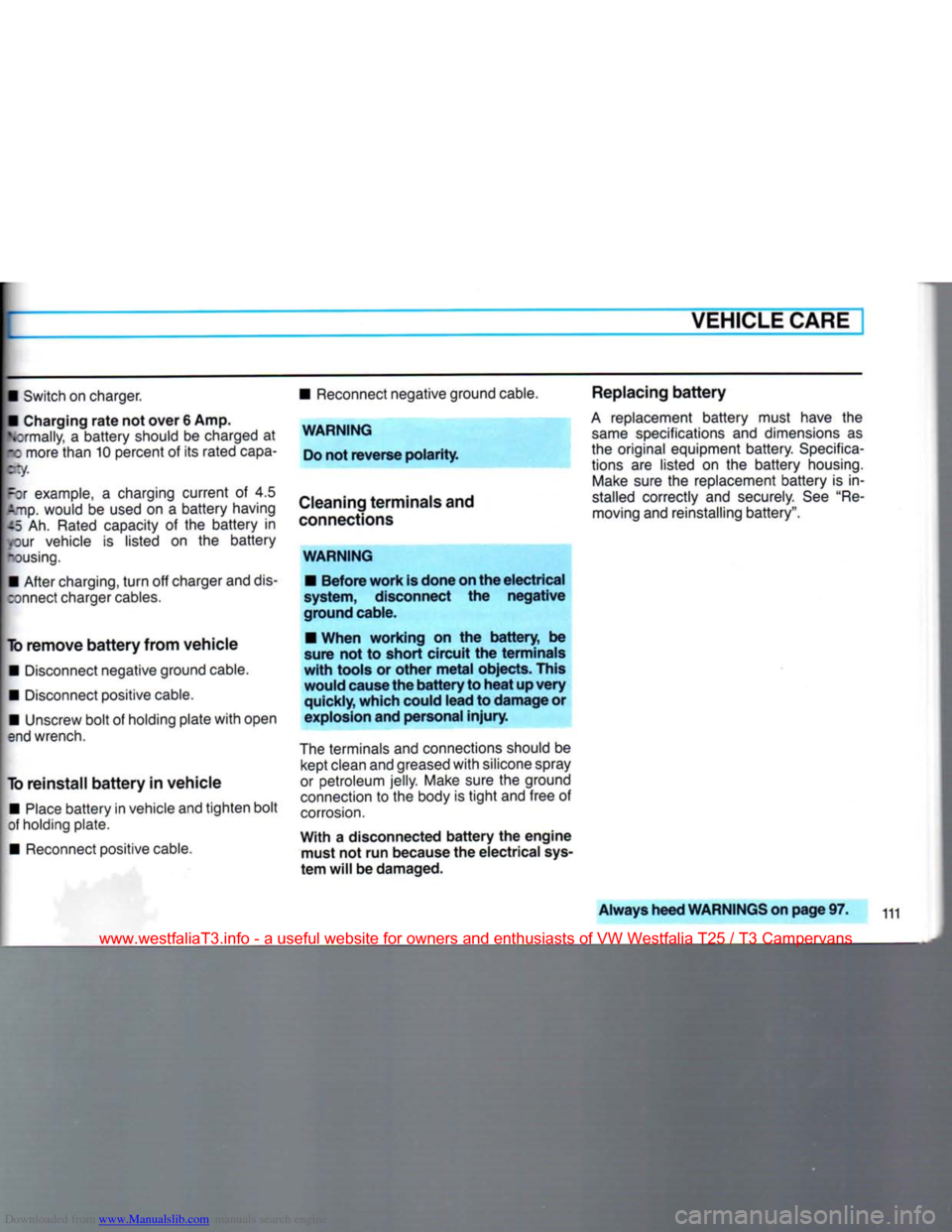
Downloaded from www.Manualslib.com manuals search engine VEHICLE CARE
• Switch on charger.
• Charging
rate
not over 6 Amp.
Vormally,
a battery should be charged at
rc more than 10 percent of its rated
capa
city.
For
example, a charging current of 4.5
Amp.
would be used on a battery having
• Ah. Rated capacity of the battery in .our vehicle is listed on the battery
"Dusing.
• After charging,
turn
off charger and dis-
ronnect charger
cables.
To
remove
battery
from
vehicle • Disconnect negative ground cable.
• Disconnect positive cable.
• Unscrew bolt of holding plate with open
end
wrench.
To
reinstall
battery
in vehicle •
Place
battery in vehicle and tighten bolt
of holding plate.
• Reconnect positive cable. • Reconnect negative ground cable.
WARNING
Do not
reverse
polarity.
Cleaning
terminals
and
connections
WARNING
• Before
work
is done on the
electrical
system, disconnect the
negative
ground cable.
•
When
working
on the
battery,
be
sure not to short circuit the
terminals
with
tools or
other
metal
objects. This
would
cause the
battery
to
heat
up
very
quickly,
which
could
lead
to
damage
or
explosion and personal
injury.
The
terminals and connections should be kept clean and greased with silicone spray
or
petroleum jelly. Make sure the ground
connection
to the body is
tight
and free of
corrosion.
With
a disconnected
battery
the
engine
must
not run because the
electrical
sys
tem
will
be damaged. Replacing
battery
A
replacement battery must have the
same
specifications and dimensions as
the original equipment battery.
Specifica
tions are listed on the battery housing.
Make
sure the replacement battery is in
stalled
correctly and securely. See "Re moving and reinstalling battery".
Always heed
WARNINGS
on
page
97.
www.westfaliaT3.info - a useful website for owners and enthusiasts of VW Westfalia T25 / T3 Campervans
Page 117 of 165
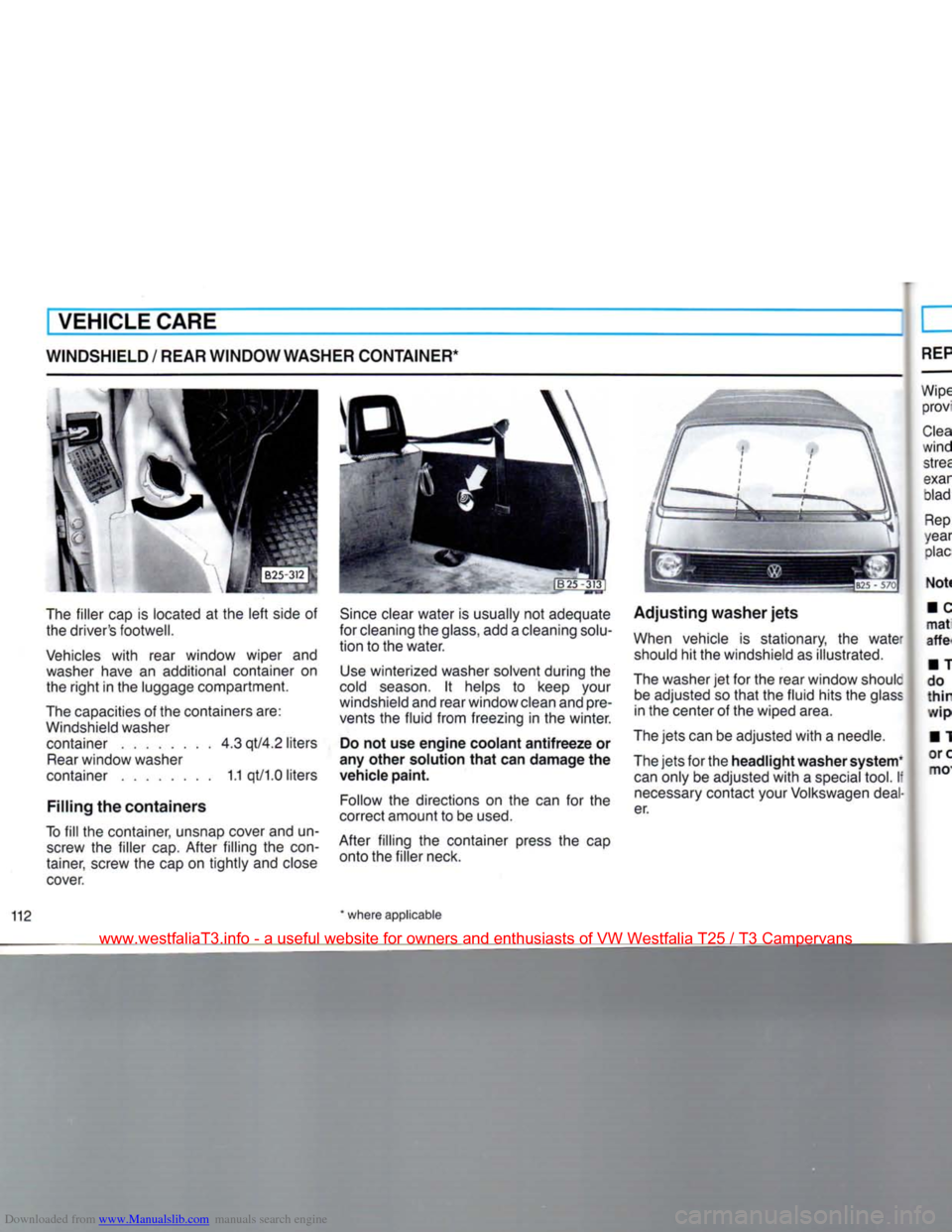
Downloaded from www.Manualslib.com manuals search engine
VEHICLE CARE
WINDSHIELD / REAR WINDOW WASHER CONTAINER*
The filler cap is iocated at the left side of the driver's footwell.
Vehicles with rear window wiper and washer have an additional container on
the right in the luggage compartment.
The capacities of the containers are: Windshield washer
container 4.3 qt/4.2 liters Rear window washer
container 1.1 qt/1.0 liters
Filling the containers
To fill the container, unsnap cover and un screw the filler cap. After filling the
con
tainer, screw the cap on tightly and close
cover. Since clear water is usually not adequate
for cleaning the glass, add a cleaning
solu
tion to the water.
Use winterized washer solvent during the
cold season. It helps to keep your
windshield and rear window clean and pre
vents the fluid from freezing in the winter.
Do not use engine coolant antifreeze or
any other solution that can damage the
vehicle paint.
Follow the directions on the can for the
correct amount to be used.
After filling the container press the cap onto the filler neck. Adjusting washer jets
When vehicle is stationary, the wate- should hit the windshield as illustrated.
The washer jet for the rear window shoulc be adjusted so that the fluid hits the glass
in the center of the wiped area.
The jets can be adjusted with a needle.
The jets for the headlight washer system' can only be adjusted with a special
tool.
If necessary contact your Volkswagen
deal
er.
112 * where applicable
www.westfaliaT3.info - a useful website for owners and enthusiasts of VW Westfalia T25 / T3 Campervans
Page 118 of 165
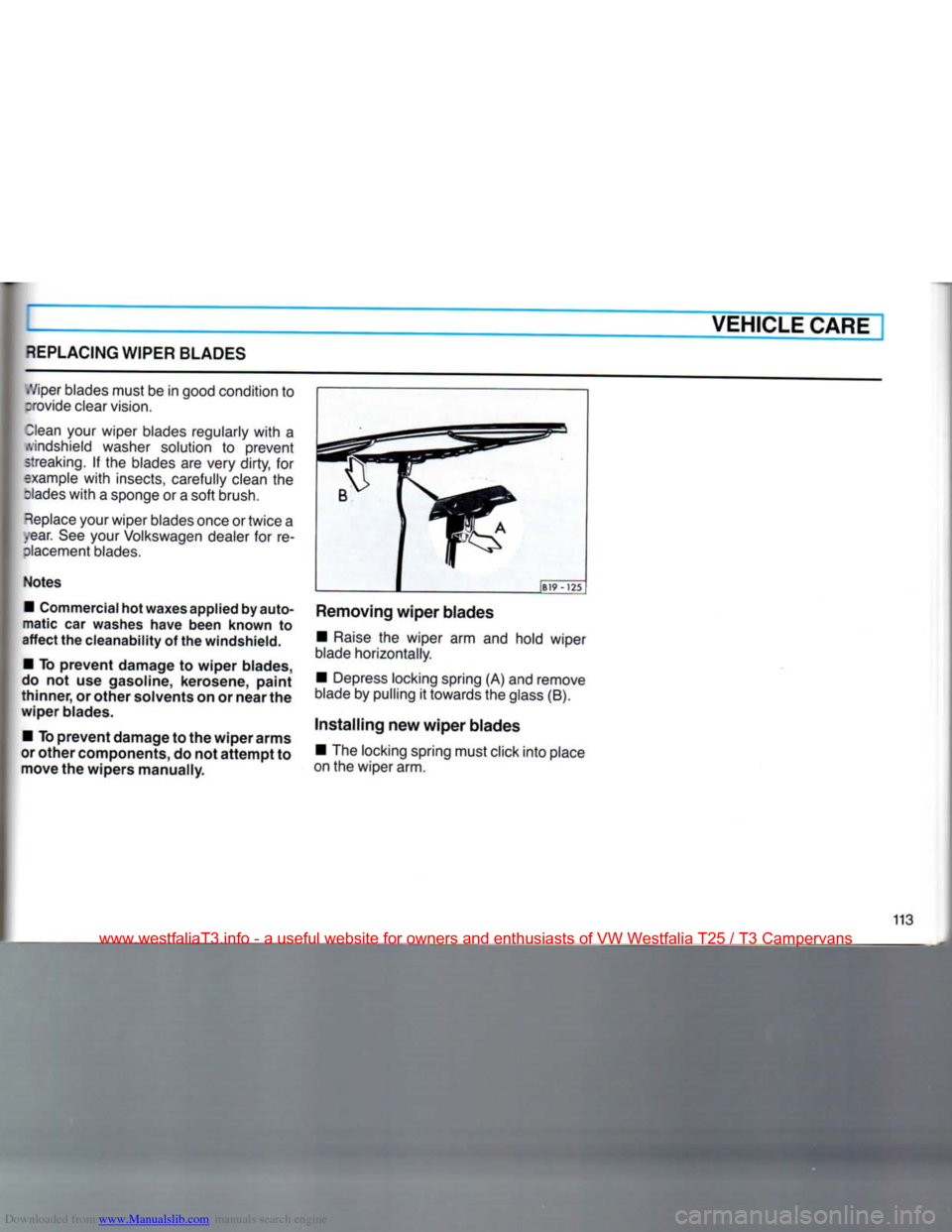
Downloaded from www.Manualslib.com manuals search engine
VEHICLE CARE
REPLACING
WIPER
BLADES
•Viper
blades must be in good condition to
:rovide clear vision.
3lean
your wiper blades regularly
with
a vindshield washer solution to prevent
streaking.
If the blades are very dirty, for
example
with
insects, carefully clean the
:lades
with
a sponge or a soft brush.
Replace
your wiper blades once or twice a
/ear.
See your Volkswagen dealer for re-
Dlacement
blades.
Notes
• Commercial hot
waxes
applied
by
auto
matic
car
washes
have
been
known
to
affect
the
cleanability
of the windshield.
• To
prevent
damage
to
wiper
blades,
do not use gasoline, kerosene,
paint
thinner,
or
other
solvents on or
near
the
wiper
blades.
• To
prevent
damage
to the
wiper
arms
or
other
components, do not
attempt
to
move
the
wipers
manually.
Removing
wiper
blades
•
Raise
the wiper arm and hold wiper
blade
horizontally.
• Depress locking spring (A) and remove
blade
by pulling it towards the glass (B).
Installing
new
wiper
blades • The locking spring must click into place
on the wiper arm.
113
www.westfaliaT3.info - a useful website for owners and enthusiasts of VW Westfalia T25 / T3 Campervans
Page 119 of 165
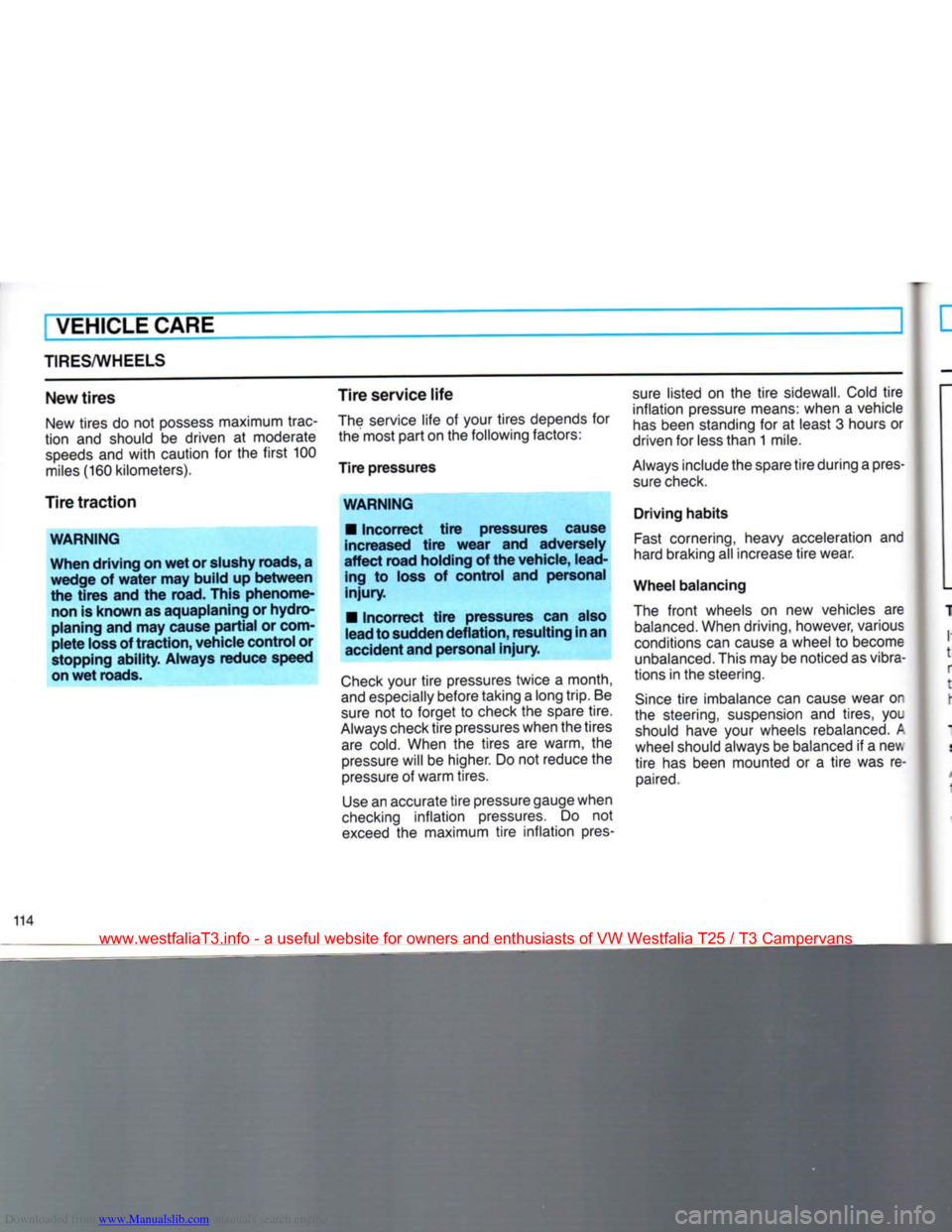
Downloaded from www.Manualslib.com manuals search engine
VEHICLE CARE
TIRES/WHEELS
New tires
New
tires
do not
possess
maximum trac
tion
and
should
be
driven
at
moderate
speeds
and
with
caution
for the
first
100
miles (160 kilometers).
Tire traction
WARNING
When driving on wet or slushy roads, a wedge of
water
may build up
between
the tires and the road. This phenome non is known as aquaplaning or hydro
planing and may cause
partial
or
com
plete
loss
of traction, vehicle control or
stopping ability. Always reduce speed
on
wet roads.
Tire service life
The service
life
of
your tires depends
for
the most
part
on the following factors:
Tire pressures
WARNING
•
Incorrect
tire
pressures cause
increased
tire
wear
and adversely
affect
road holding of the vehicle, lead ing to
loss
of control and personal
injury.
•
Incorrect
tire
pressures can also
lead to
sudden
deflation, resulting
in
an
accident and personal injury.
Check
your
tire
pressures twice
a
month,
and especially before taking
a
long
trip.
Be
sure
not to
forget
to
check
the
spare tire.
Always check
tire
pressures when the tires are cold. When
the
tires
are
warm,
the
pressure
will
be
higher.
Do not
reduce
the
pressure
of
warm tires.
Use
an accurate
tire
pressure gauge when
checking inflation pressures.
Do not
exceed
the
maximum
tire
inflation pres sure listed
on the
tire
sidewalk Cold
tire
inflation pressure means: when
a
vehicle
has
been standing
for at
least
3
hours
or
driven
for
less than 1 mile.
Always include the spare
tire
during
a
pres sure check.
Driving habits
Fast
cornering, heavy acceleration
and
hard braking all increase
tire
wear.
Wheel balancing
The
front
wheels
on new
vehicles
are
balanced.
When driving, however, various
conditions can cause
a
wheel
to
become
unbalanced.
This may
be
noticed as vibra
tions
in the
steering.
Since
tire
imbalance
can
cause wear
or
the steering, suspension
and
tires,
you
should have your wheels rebalanced.
A
wheel should always
be
balanced
if a
nev,
tire
has
been mounted
or a
tire
was re
paired.
114
www.westfaliaT3.info - a useful website for owners and enthusiasts of VW Westfalia T25 / T3 Campervans
Page 120 of 165
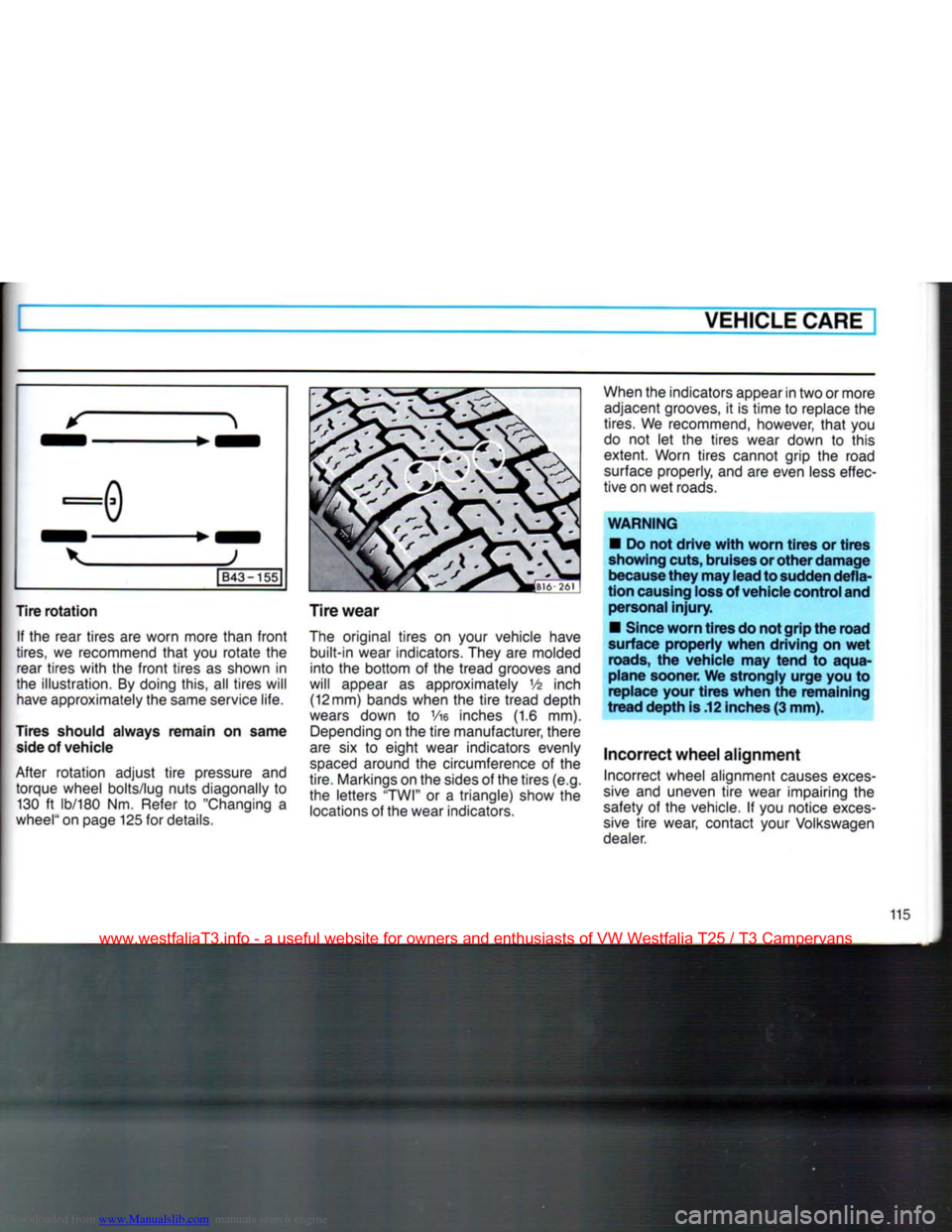
Downloaded from www.Manualslib.com manuals search engine
VEHICLE CARE
K >i
|B43-155|
Tire rotation If the
rear tires
are
worn more than
front
tires,
we
recommend
that
you
rotate
the
rear tires
with
the
front
tires
as
shown
in
the illustration.
By
doing this,
all
tires will
have
approximately the same service life.
Tires
should always remain on same
side
of vehicle
After rotation adjust
tire
pressure
and
torque wheel bolts/lug nuts diagonally
to
130
ft
lb/180
Nm.
Refer
to
"Changing
a
wheel"
on page 125
for
details.
Tire
wear
The
original tires
on
your vehicle have
built-in wear indicators. They
are
molded
into
the
bottom
of the
tread grooves
and
will appear
as
approximately
V6
inch (12 mm) bands when
the
tire
tread depth
wears
down
to Vie
inches
(1.6 mm).
Depending
on the
tire
manufacturer, there
are
six to
eight wear indicators evenly
spaced
around
the
circumference
of the
tire. Markings on the sides
of
the tires (e.g.
the letters "TWI"
or a
triangle) show
the
locations
of
the wear indicators.
When
the indicators appear in two
or
more
adjacent grooves,
it is
time
to
replace
the
tires.
We
recommend, however,
that
you
do
not let the
tires wear down
to
this
extent. Worn tires cannot grip
the
road
surface
properly, and are even
less
effec
tive on wet roads.
WARNING
•
Do not drive
with
worn tires or tires
showing
cuts,
bruises
or other damage
because
they may lead to
sudden
defla
tion
causing
loss
of
vehicle
control
and
personal
injury.
•
Since
worn tires do not grip the road
surface
properly when driving on wet
roads,
the vehicle may tend to aqua
plane sooner. We strongly urge you to
replace your tires when the remaining
tread depth is .12
inches
(3 mm).
Incorrect
wheel
alignment
Incorrect wheel alignment
causes
exces
sive
and
uneven
tire
wear impairing
the
safety
of the
vehicle.
If
you notice
exces
sive
tire
wear, contact your Volkswagen
dealer.
115
www.westfaliaT3.info - a useful website for owners and enthusiasts of VW Westfalia T25 / T3 Campervans